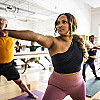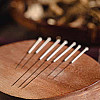Core conditioning: It's not just about abs
Lots of women would like to firm up their tummies. Working on core muscles can help with that — and much more.
Many of us have wished for flatter stomachs, a goal that seems more frustrating and elusive the older we get. You might have been tempted by infomercials for exercise devices or breathless magazine articles promising "flat abs" and tighter tummies "in just days." Despite the hype, spot exercising abdominal muscles won't get rid of fat. The only way to do that is to expend more calories than you take in. Working these muscles has its place, but the smart money these days is on strengthening a variety of trunk muscles, collectively known as "the core."
Core conditioning improves posture, which contributes to a trimmer appearance (poor posture can give even a woman with well-toned abs a little "pot"). Moreover, developing core muscle strength can boost the effectiveness of workouts and reduce the risk of injuries that sideline our efforts to stay in shape.
Getting at the core
If you've ever had physical therapy to treat low back pain, you're probably familiar with the concept of strengthening the core — the muscles in the abdomen, lower back, and pelvis that lie roughly between the rib cage and the hips. The strength and coordination of these muscles is important not only for sports and fitness routines but also for daily life — for example, reaching up to a shelf, lifting a child, or sponging a spot off the floor.
The current drive behind core conditioning comes in part from studies conducted in the 1990s showing that before they move an arm or leg, people with healthy backs (in contrast with those suffering from low back pain) automatically contract their core muscles, especially the transverse abdominal muscles, which wrap from the sides of the lower back around to the front. Experts concluded that well-coordinated core muscle use stabilizes the spine and helps create a firm base of support for virtually all movement. The role of the core is also central to the Pilates method, a series of exercises developed during World War I to help rehabilitate soldiers returning from the war. Its founder, Joseph Pilates, referred to the core as the "powerhouse."
These days, patients who are receiving physical therapy for chronic low back pain or injury are told to contract their core muscles before performing prescribed exercises. And Pilates exercises are increasingly incorporated into health club workouts, along with other approaches that engage the core, such as fitness (stability) balls, yoga, and tai chi.
Exercises that strengthen abdominal and other core muscles should be part of an overall fitness plan that includes regular moderate-intensity aerobic exercise, such as brisk walking, 30 minutes per day, most days of the week. Guidelines also encourage us to get 20 to 30 minutes of strength training two to three times a week, and that might be a good time to fit in a few exercises designed to work the core.
|
Selected resources American College of Sports Medicine317-637-9200www.acsm.org American Council on Exercise"Health and Fitness Information"www.acefitness.org/getfit |
Sample exercises
To be safe and effective, core muscle strengthening exercises require proper alignment and progression from one type of exercise to another — adjusted to your body and fitness level. So you may want to ask a physical therapist or exercise professional for help in planning a program for you. (If you haven't been physically active or have back problems or some other medical condition, consult a clinician before embarking on any fitness program.)
You'll probably start by learning how to "draw in" — the first step in performing all core exercises and a basic tool you can use in almost any physical activity you perform (including walking). Here's what you do: Sitting, standing, or lying on your back, gently but firmly tighten the abdominal muscles, drawing the navel in toward the small of the back. The tailbone should be slightly tucked. (Some trainers prefer to call it "bracing" the muscles, as if you were preparing to take a punch in the stomach.) Practice holding this position for 10 seconds at a time while breathing normally (that's the hard part!). Once you get the hang of drawing in, you can start doing some core exercises, progressing from those you do on a stable surface (the floor or a mat) to those performed on an unstable surface, like a stability ball.
Below are just a few exercises that can help strengthen core muscles. If you decide to try any of them, go slowly, work at your own pace, and don't keep doing anything that causes pain. Concentrate on performing the exercises correctly, not on the number of repetitions or how quickly you can do them. And don't forget to breathe!
Basic crunch

Lie on your back with your knees bent and feet flat on the floor. Place your fingertips at the back of your head. Tighten your abdominal muscles; then curl your upper body forward, lifting your shoulder blades off the floor. Hold for one or two seconds. Slowly lower halfway to the floor; then repeat. Work up to 12 to 16 crunches. Note: Don't speed through the crunches!
Reverse crunch

Lie with your back pressed to the ground, your hands at your sides, your knees bent, and your feet off the floor (ankles crossed) so that your knees create a 90-degree angle. Tighten your abdominal muscles, and raise your hips toward your rib cage, curling your tailbone off the floor (see illustration). Hold for a second or two; then slowly lower your hips to the starting position. Work up to 12 to 16 repetitions. Note: Use your hands at first to help stabilize yourself, but rely on them less as you get stronger.
Plank

Lie stomach-down on a mat, resting on your forearms (like a sphinx). Tighten your abdominal muscles, and press up so you're balanced on your toes and elbows (see illustration). Don't let your hips sag or stick up: your body should be in a straight line from head to heels. Hold for 20 to 30 seconds; then lower and repeat a few more times. Work up to holding the plank position for 60 seconds.
Arm and leg raise

Lie on your stomach with your arms above your head. Tighten your stomach muscles; then lift your right arm and left leg (see illustration). Hold for five seconds. Lower, and rest a moment; then repeat with the left arm and right leg. Work toward eight to 12 repetitions on each side. Note: Avoid arching your back (keep your abdominal muscles engaged and your pelvis tucked). When you're ready for more, try lifting the leg and arm on the same side.
Bicycle

Lie flat on the floor on your back. Place your fingertips at the back of your head. Tighten your abdominal muscles, bring your knees up to a 45-degree angle, and lift your shoulder blades off the ground. Turn your upper body to the left, bringing the right elbow toward the left knee and extending your right leg (see illustration). Switch sides, bringing the left elbow toward the right knee. Continue this pedaling motion, slowly, for a total of 12 to 16 repetitions. Rest and repeat. Note: Avoid pulling on the neck.
Stability balls
Because the ball is intrinsically unstable, core muscle activity is greater when you perform certain exercises on it (a crunch, for example) than when you perform the same exercises on a stable surface. Stability balls come in various sizes (35 to 85 centimeters — 14 to 34 inches — in diameter). Check the label on the box to find the correct size for your height. Start by sitting upright on the ball with your feet flat on the floor. To get a feel for remaining balanced, move your hips from side to side, then in circles.
Arm and leg raise on the ball

Lie over the ball so that your hips are on top of it and your legs are straight. Toes and fingers should comfortably reach the floor. Tighten your stomach muscles, then lift your right arm and left leg (see illustration). Hold for five seconds; rest a moment; then repeat with the left arm and right leg. Do eight to 12 repetitions. When you're ready for more, try lifting the same leg and arm.
Exercise ball crunch

Sit on the ball with your feet flat on the floor, hip-width apart. Let the ball roll back slowly until your thighs and hips are parallel to the floor (you may need to walk your feet out a bit) and the ball is at your lower back. Place your fingertips at the back of your head. Keeping your lower body still, contract your abdominal muscles and curl your upper body forward, lifting your shoulder blades off the ball (see illustration). Hold for a second or two; then lower your upper back. Repeat a total of 12 to 16 times. Note: When you're ready for more, move your feet closer together. Exhale as you contract; inhale as you return to the starting position.
Disclaimer:
As a service to our readers, Harvard Health Publishing provides access to our library of archived content. Please note the date of last review or update on all articles.
No content on this site, regardless of date, should ever be used as a substitute for direct medical advice from your doctor or other qualified clinician.












